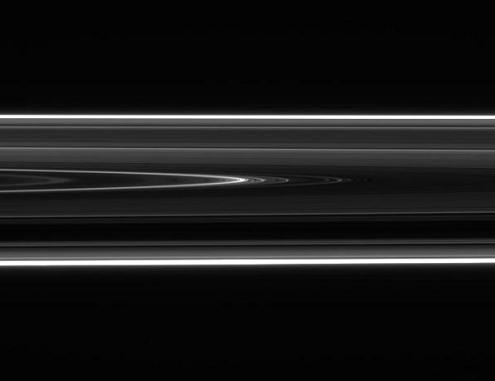Scientists studying the images received from Cassini have seen a structure in the outer part of the D ring that looks like a series of tiny bright rings, spaced 30 kilometers apart. An observation made by the Hubble Space Telescope in 1995 also revealed a periodic structure in the D ring, but at that time the distance between the rings was 60 kilometers

Scientists working on the Cassini mission discovered a change that indicated a comet or asteroid had recently collided with the D ring, one of the faintest of Saturn's rings.
Scientists studying the images received from Cassini have seen a structure in the outer part of the D ring that looks like a series of tiny bright rings, spaced 30 kilometers apart. An observation carried out by the Hubble Space Telescope in 1995 also revealed a periodic structure in the D ring, but at that time the distance between the rings was 60 kilometers, unlike many of the configurations in the ring system that have not changed over the past decades, the spacing in this pattern is small over the years.
These findings were presented last Thursday at the Planetary Society Division Conference at the American Astronomical Society meeting in Pasadena, California.
"The structure in the D ring reminds us that Saturn's rings are not eternal, but active and dynamic systems that can change and evolve," said Dr. Math Hedman, a member of the Cassini imaging team at Cornell University, in Ithaca, New York.
When the Cassini researchers viewed the D ring in line with the plane of the rings, they saw a repeating pattern of brightness - a part of the ring that appears brighter on the far side of the ring appears dark when it is on the near side of the ring and vice versa.
This phenomenon can occur in areas containing sheets of fine materials, which respond to changes in the gradients of the annular material waves. Both the change over time and the wavy structure of the area may be explained by the collision of a comet or meteorite in the D ring, which therefore blew up a cloud of fine particles. This cloud took on the inclination of the orbit of the colliding object as it crashed into the rings. An alternative explanation may be that the object may have been a tiny moon that fell from its orbit, tearing into pieces and scattering them in its inclined orbit.
In each case, the researchers estimate that the consequences of such a collision is that the ring would tilt relative to Saturn's equatorial plane. Over time, as the particles develop a biased motion, these smooth sheets of matter may become a wavy coil that spreads out like fountain water over time, which is what we have now observed.
Based on the 1995 and 2006 observations, the scientists performed a backward projection of the process and now estimate that the collision occurred in 1984.
